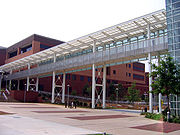
Klaus Advanced Computing Building
Encyclopedia

Georgia Institute of Technology
The Georgia Institute of Technology is a public research university in Atlanta, Georgia, in the United States...
that houses a portion of its College of Computing
Georgia Institute of Technology College of Computing
The College of Computing at the Georgia Institute of Technology has roots stretching back to an Information Science degree established in 1964. In 1988, Georgia Tech president John Patrick Crecine elevated the School of Information and Computer Science to become the College of Computing, making...
, College of Engineering
Georgia Institute of Technology College of Engineering
The College of Engineering at the Georgia Institute of Technologyprovides formal education and research in more than 10 fields of engineering, including:...
, and related programs.
Financing
In 2000, the building was financed by a $United States dollar
The United States dollar , also referred to as the American dollar, is the official currency of the United States of America. It is divided into 100 smaller units called cents or pennies....
15 million donation from successful internet entrepreneur and former Georgia Tech student Chris Klaus
Chris Klaus
Christopher W. Klaus is the founder and current CEO of Kaneva, LLC and founder and former CTO of Internet Security Systems ....
. Klaus was a founder of both Kaneva and Internet Security Systems
Internet Security Systems
IBM Internet Security Systems is a security software provider which was founded in 1994 as Internet Security Systems, and is often known simply as ISS or ISSX...
. At the time of Klaus' contribution, it was the fifth-largest contribution by an individual in Georgia Tech's history. Klaus was 26 when he made the donation.
Planning
Architect Perkins+WillPerkins and Will
Perkins+Will was founded in Chicago in 1935 by and ., on the belief that design has the power to transform lives and enhance society...
was selected. The site of the old Health Center was selected for the new computing building's location, and a new $7.1 million Health Center was built near the Georgia Tech Campus Recreation Center to free up that land. The Health Center faculty were then moved to the new facility in March 2003. Construction was initially planned to start in Summer 2003, but there was some difficulty in the ownership of the many parcels that the site encompassed. Several were of uncertain ownership, and Georgia Tech had to verify that it owned every part of the site before the Georgia Board of Regents
Georgia Board of Regents
The Georgia Board of Regents oversees the University System of Georgia as part of the state government of Georgia in the United States. The University System of Georgia is composed of all state public institutions of higher education.-History:...
would allow construction to proceed.
"[I]f you look at some old maps, way, way back when [Tech] was just a few buildings, these [parcels] were all home sites... Before the Board of Regents will allow anyone to build on a site, they have to have the deed in hand and know that the property belongs to the Board of Regents... That was a major, major issue for us... [W]e literally had to go through [each parcel] with the city and everybody else trying to reconcile who’s the owner."
Construction bids were set in December 2003, and the winning contractor was scheduled to begin in early January. General contractors WG Yates & Sons Construction received permission from the state to occupy the site in February 2004. From that date, the project was expected to take two years to complete.
Construction
There was a "Virtual Ground Breaking" ceremony on April 1, 2004 that featured a 3d virtual tourVirtual Tour
A virtual tour is a simulation of an existing location, usually composed of a sequence of video images. They also may use other multimedia elements such as sound effects, music, narration, and text....
of the building. Construction was then delayed somewhat by a rainy summer and a large amount of subsurface rock; the latter required the use of explosives to clear.
"Students who attended classes in the summer felt frequent tremors in the College of Computing as the explosives were set off... [Construction project manager Ron] Leroy’s team sent out email notices and conducted meetings with faculty who would be affected by the blasts, but they still had a disruptive effect on classes in the area."
Crews closed in the building in Summer 2005. The building was officially opened on October 26, 2006.
Features

It has been cited as environmentally friendly, and earned the United States Green Building Council
United States Green Building Council
The U.S. Green Building Council , co-founded by Mike Italiano, David Gottfried and Rick Fedrizzi in 1993, is a non-profit trade organization that promotes sustainability in how buildings are designed, built, and operated...
's Leadership in Energy and Environmental Design
Leadership in Energy and Environmental Design
Leadership in Energy and Environmental Design consists of a suite of rating systems for the design, construction and operation of high performance green buildings, homes and neighborhoods....
(LEED) Gold Certification. Several of those features include extensive green space (over 50 percent of the 6 acres (24,281.2 m²) site), a storm water collection system that provides water for irrigation, energy efficient heating and cooling systems, waterless urinals, and extensive use of recyclables.

